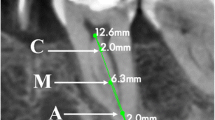Abstract
Purpose
The main goal of the present study was to verify the presence, spatial location, the end of the canalis sinuosus (CS) trajectory and size of CS using cone beam computed tomography (CBCT) to characterise it as either a structure or an anatomical variation.
Methods
A trained examiner specialist in dental radiology and imagenology selected 200 CBCT images of the maxilla from 107 (53.5%) female and 93 (46.5%) male individuals aged between 18 and 85 years.
Results
A total of 133 (66.5%) patients had CS, being 61 (45.86%) unilateral and 72 (54.14%) bilateral. A higher frequency of CS was observed in males (P < 0.05) and no relationship was found between its presence and age. The end of the CS trajectory was more frequent in the regions of central incisor (n = 91; 44.39%), followed by lateral incisor (n = 45; 21.95%) and canine (n = 29; 14.15%). In our sample, the majority of these canals had a diameter of up to 1 mm (n = 198/205; 96.6%). No statistically significant relationship between diameter and the end of the CS trajectory, with location (i.e. bilateral or unilateral) was found. Gender and age had no influence on diameter, spatial location and the end of the CS trajectory (P > 0.05%).
Conclusion
As CS was frequently found in our sample, it can be considered an anatomical structure, and as such, it is fundamental that the dentist requests a CBCT examination before performing any invasive procedure in the maxillary region to preserve this important structure.




Similar content being viewed by others
References
Arruda JA, Silva P, Silva L, Álvares P, Silva L, Zavanelli R, Rodrigues C, Gerbi M, Sobral AP, Silveira M (2017) Dental implant in the canalis sinuosus: a case report and review of the literature. Case Rep Dent 8:1–5
De Chacón VERG, Becerra JMM (2017) Canalis sinuosus: report de cuatro casos y revisión de la literatura. Rev Estomatol Herediana 27:39–43
Ghandourah AO, Rashad A, Heiland M, Hamzi BM, Friedrich RE (2017) Cone-beam tomographic analysis of canalis sinuosus accessory intraosseous canals in the maxilla. Ger Med Sci 15:1–12
Gurler G, Delilbasi C, Ogut EE, Aydin K, Sakul U (2017) Evaluation of the morphology of the canalis sinuosus using cone beam computed tomography in patients with maxillary impacted canines. Imaging Sci Dent 47:69–74
Jones FW (1939) The anterior superior alveolar nerve and vessels. J Anat 73:583–591
Kim JH, Abdala R Jr, Aoki EM, Baladi MG, Cortes ARG, Watanabe PCA, Arita ES (2015) Canalis sinuosus and radiographic procedures in the region of anterior maxilla. Clin Lab Res Dent 21:180–184
Kose EMRE, Sekerci AE, Soylu E, Nazlim S (2014) An extremely rare anatomical variation bilateral canalis sinuosus and nasopalatine duct cyst and role of TCCB in diagnosis. Int J Sci Res 23:361–363
Leven AJ, Sood B (2018) Pathosis or additional maxillary neurovascular channel? A case report. J Endod 44:1048–1051
Machado VC, Chrcanovic BR, Felippe MB, Manhães LRC Jr, Carvalho PSP (2016) Assessmet of accessory canals of the canalis sinuosus: a study of 1000 cone beam computed tomography examinations. Int J Oral Maxillofacc 45:1586–1591
Manhães LRC Jr, Villaça-Carvalho MF, Moraes ME, Lopes SL, Silva MB, Junqueira JL (2016) Location and classification of canalis sinuosus for cone beam computed tomography: avoiding misdiagnosis. Bras Oral Res 30:e49
McCrea SJJ (2017) Aberrations causing neurovascular damage in the anterior maxilla during dental implant placement. Case rep Dent 2017:5969643
Neves FS, Crusoé-Souza M, Franco LCS, Caria PHF, Bonfim-Almeida P, Crusoé-Rebello I (2012) Canalis sinuosus: a rare anatomical variation. Surg Radiol Anat 34:563–566
Oliveira-Santos C, Rubira-Bullen IRF, Monteiro SAC, León JE, Jacobs R (2013) Neurovascular anatomical variations in the anterior palate observed on CBCT images. Clin Oral Implants Res 24:1044–1048
Orhan K, Gorurgoz C, Akyol M, Ozarslanturk S, Avsever H (2018) An anatomical variant: evaluation of accessory canals of the canalis sinuosus using cone beam computed tomography. Folia Morphol 77:551–557
Rusu MC, Sãndulescu M, Bichir C, Muntianu LAS (2017) Combined anatomical variations: the mylohyoid bridge, retromolar canal and accessory palatine canals branched from the canalis sinuosus. Ann Anat 214:75–79
Shah PN, Arora AV, Kapoor SV (2017) Accessory branch of canalis sinuosus mimicking external root resorption: a diagnostic dilemma. J Conserv Dent 20:479–481
Shelley AM, Rushton VE, Horner K (1999) Canalis sinuosus mimicking a periapical inflammatory lesion. Br Dent J 186:378–379
Torres MGG, Valverde LF, Vidal MT, Crusoe-Rebello IM (2015) Branch of the canalis sinuosus: a rare anatomical variation—a case report. Surg Radiol Anat 37:879–881
Von Arx VT, Lozanoff S, Sendi P, Bornstein MM (2013) Assessment of bone channels other than the nasopalatine canal in the anterior maxilla using limited cone beam computed tomography. Surg Radiol Anat 35:783–790
Wanzeler AMV, Marinho CG, Alves SM Jr, Manzi F, Tuji FM (2015) Anatomical study of canalis sinuosus in 100 cone beam computed tomography examinations. Oral Maxillofacc Surg 19:49–53
Author information
Authors and Affiliations
Corresponding author
Ethics declarations
Conflict of interest
The authors declare no conflict of interest.
Additional information
Publisher's Note
Springer Nature remains neutral with regard to jurisdictional claims in published maps and institutional affiliations.
Rights and permissions
About this article
Cite this article
Aoki, R., Massuda, M., Zenni, L.T.V. et al. Canalis sinuosus: anatomical variation or structure?. Surg Radiol Anat 42, 69–74 (2020). https://doi.org/10.1007/s00276-019-02352-2
Received:
Accepted:
Published:
Issue Date:
DOI: https://doi.org/10.1007/s00276-019-02352-2




